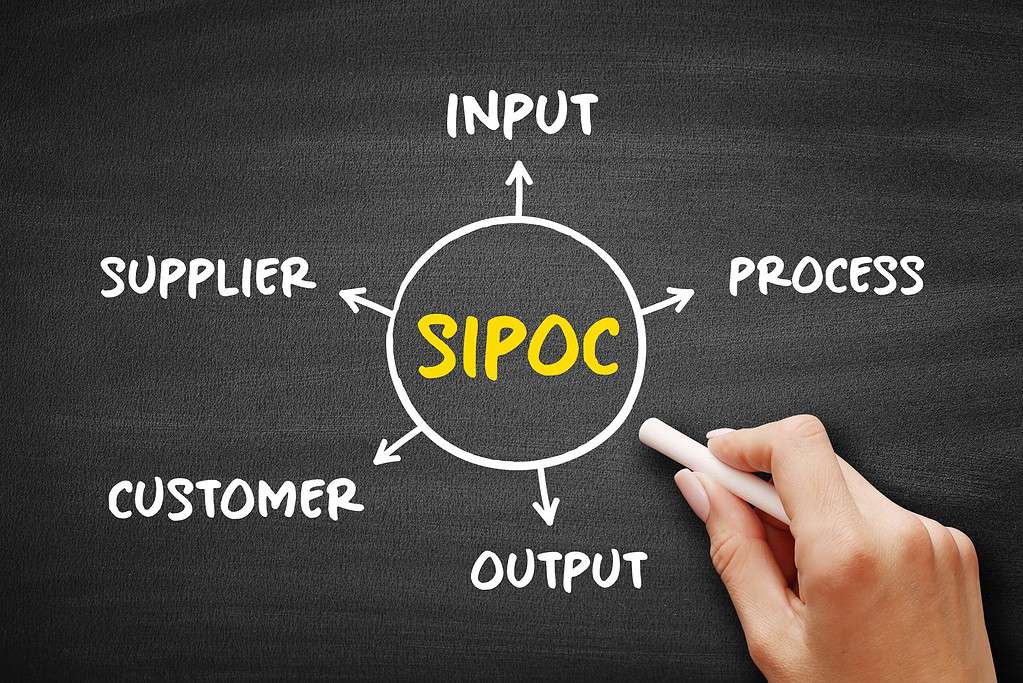
© Ground Picture/Shutterstock.com
Key Points
- Clearly outline workflows, roles, and communication points using tools like SIPOC diagrams to ensure alignment and reduce confusion in hybrid teams.
- Consolidate and establish clear guidelines for using specific communication platforms (e.g., email, instant messaging, and video calls) to prevent fragmented communication.
- Use Lean principles to streamline meetings with clear agendas, limited participants, and time-boxed discussions while visualizing workflows through tools like Kanban boards for enhanced transparency.
- Regularly collect feedback through surveys or retrospectives to identify and address communication gaps, ensuring continuous improvement in hybrid collaboration.
The workplace landscape has undergone a dramatic transformation with the widespread adoption of hybrid work models. This shift, accelerated by the global pandemic, combines remote and in-office work, offering employees flexibility and autonomy while enabling organizations to reduce operational costs. However, this model also presents unique challenges, particularly in communication, collaboration, and process improvement. Lean Six Sigma, a methodology focused on improving efficiency and reducing waste, can provide solutions to these challenges, ensuring hybrid workplaces thrive. This article explores how Lean Six Sigma can overcome communication barriers in hybrid work environments and offers actionable recommendations for implementation.

©Maples Images/Shutterstock.com
Understanding Communication Barriers in Hybrid Workplaces
Communication barriers in hybrid workplaces arise from several factors, including:
- Geographical Dispersion: Employees are distributed across different locations, time zones, and working hours.
- Technology Dependency: Reliance on digital tools can lead to information silos and miscommunication.
- Cultural and Generational Differences: Diverse teams may face challenges in understanding and aligning communication norms.
- Lack of Visibility: Remote workers often feel disconnected from office dynamics and decision-making processes.
These barriers can hinder collaboration, slow down decision-making, and lead to inefficiencies, counteracting the goals of Lean Six Sigma.
Leveraging Lean Six Sigma to Address Communication Barriers
Lean Six Sigma principles, rooted in data-driven decision-making and continuous improvement, can be instrumental in addressing communication challenges in hybrid workplaces. Below are strategies to integrate Lean Six Sigma effectively.
1. Define and Align Processes
A clear understanding of roles, responsibilities, and workflows is critical in hybrid workplaces. The Define phase of Lean Six Sigma DMAIC process provides a structured approach to establish clarity and alignment.
- Actionable Recommendation: Create a detailed process map that outlines workflows, stakeholders, and communication points. For example, use a SIPOC diagram (Suppliers, Inputs, Process, Outputs, Customers) to visualize end-to-end processes.
- Example: A marketing team can use a SIPOC diagram to define the steps involved in campaign creation, ensuring all team members understand their roles, whether they work remotely or in-office.

2. Measure and Analyze Communication Gaps
The Measure and Analyze phases focus on identifying inefficiencies and root causes of communication breakdowns.
- Actionable Recommendation: Conduct surveys or focus groups to gather feedback on communication challenges. Use tools like Pareto charts or cause-and-effect diagrams (Fishbone or Ishikawa diagrams) to analyze issues.
- Example: A tech company identified that delayed project updates were causing missed deadlines. By analyzing feedback, they discovered that inconsistent use of project management tools was the root cause.
3. Standardize Communication Channels
Hybrid workplaces often suffer from fragmented communication due to the use of multiple tools. Standardizing communication channels can mitigate this.
- Actionable Recommendation: Establish guidelines on when and how to use specific tools (e.g., email for formal updates, instant messaging for quick queries, video calls for complex discussions).
- Example: A financial services firm implemented a policy where all project-related discussions occur on a single platform like Microsoft Teams, reducing email overload and enhancing traceability.
4. Optimize Meetings
Meetings in hybrid workplaces can become unproductive if not managed effectively. Lean Six Sigma emphasizes value-added activities, which apply to meetings as well.
- Actionable Recommendation: Use Lean principles to streamline meetings. Set clear agendas, limit attendees to essential participants, and allocate time for action items.
- Example: An HR team reduced meeting times by 30% by introducing a “stand-up meeting” format where updates are concise and focused.
5. Visualize the Workflows and Metrics
Transparency in workflows and metrics fosters better communication and accountability.
- Actionable Recommendation: Implement visual management tools like Kanban boards or dashboards to track tasks and performance metrics.
- Example: A software development team used a Kanban board to visualize sprint progress, enabling both remote and in-office members to stay aligned.
6. Foster a Culture of Continuous Feedback
Feedback loops are essential in Lean Six Sigma to drive continuous improvement. Hybrid workplaces benefit from structured and regular feedback.
- Actionable Recommendation: Schedule regular retrospectives or “lessons learned” sessions to discuss communication improvements.
- Example: A sales team conducted bi-weekly retrospectives to refine their client engagement strategies, leading to a 15% improvement in response times.
Case Study: Lean Six Sigma in a Hybrid Marketing Team
A global marketing team faced challenges in coordinating campaigns due to time zone differences and fragmented communication. By applying Lean Six Sigma, they:
- Defined Processes: Created a SIPOC diagram to clarify responsibilities and workflows.
- Measured Gaps: Used surveys to identify that delayed approvals were a major bottleneck.
- Standardized Tools: Consolidated communication to a single platform, ensuring consistent updates.
- Optimized Meetings: Introduced a weekly “campaign sync” meeting with a time-boxed agenda.
- Visualized Progress: Adopted a Kanban board to track tasks, ensuring visibility for all team members.
- Feedback Loops: Implemented quarterly retrospectives to address new challenges.
As a result, the team reduced campaign turnaround time by 20% and improved overall collaboration.

©Ground Picture/Shutterstock.com
Best Practices for Driving Lean Six Sigma in Hybrid Workplaces
To ensure successful implementation, consider these best practices:
- Leadership Buy-In: Leaders should champion Lean Six Sigma initiatives, modeling the desired communication behaviors.
- Training and Awareness: Provide training on Lean Six Sigma tools and principles to equip employees with the necessary skills.
- Adaptability: Customize Lean Six Sigma practices to fit the unique needs of the hybrid workplace.
- Technology Integration: Leverage tools that support collaboration, such as cloud-based project management platforms and communication apps.
- Employee Involvement: Engage employees in identifying and solving communication challenges to foster ownership and commitment.
How AI Can Facilitate Lean Six Sigma in Hybrid Workplaces
Artificial intelligence (AI) is a powerful enabler of Lean Six Sigma (LSS) methodologies, especially in hybrid workplaces where communication, collaboration, and efficiency challenges are prevalent. By leveraging AI, organizations can streamline processes, improve decision-making, and enhance communication across distributed teams.
- Data Collection and Analysis: AI can automate data gathering from multiple sources such as project management tools, communication platforms, and workflow systems. It processes vast amounts of data rapidly, identifying inefficiencies, bottlenecks, and waste in real-time. AI-driven analytics provide actionable insights to support LSS’s Measure and Analyze phases.
- Process Automation: AI tools, such as robotic process automation (RPA), can handle repetitive tasks, reducing errors and freeing up employees to focus on value-added activities. This aligns with LSS principles of reducing waste and enhancing efficiency.
- Predictive Analytics: AI can forecast trends and potential issues, helping teams proactively address challenges before they escalate. This supports the Control phase of LSS by ensuring processes remain stable and efficient over time.
- Enhanced Communication: AI-powered tools like chatbots and virtual assistants facilitate smoother communication by providing instant responses to queries, scheduling meetings, and ensuring that information flows seamlessly across hybrid teams.
- Personalized Training: AI can offer tailored LSS training modules to employees based on their roles, ensuring consistent understanding and application of LSS principles in diverse and geographically dispersed teams.
Similar Concepts
The concept of hybrid teams is like the idea of remote teams since hybrid teams have a significant component of their time being spent outside of the physical office or workplace. Here are three articles on how to manage remote teams while deploying Lean Six Sigma.
- This article discusses the common challenges of remote work and how to overcome them.
- A similar article describes how to maintain company culture in remote work environments.
- This final article suggests some tools to help increase productivity in remote work environments.

©Ground Picture/Shutterstock.com
Final Thoughts
Driving Lean Six Sigma in hybrid workplaces requires a deliberate focus on overcoming communication barriers. By defining processes, standardizing tools, optimizing workflows, and fostering continuous improvement, organizations can enhance collaboration and efficiency. The hybrid model is here to stay, and with Lean Six Sigma, businesses can ensure it remains a catalyst for success rather than a hurdle to overcome.
The image featured at the top of this post is ©Ground Picture/Shutterstock.com.